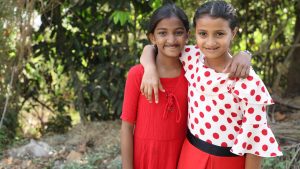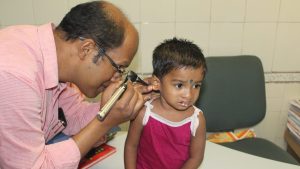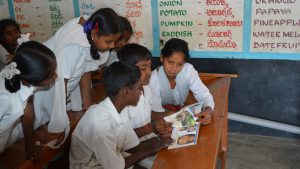Extreme poverty is far more complex than it might appear at first glance. It is often passed down from generation to generation, and in order to escape it, it is often not enough to address just one cause. The “vicious circle of poverty” is a set of interlocking factors that make it incredibly difficult for the people affected to escape their desperate situation.
Education School, friends, light-heartedness. For children from poor families, this is often just a dream. Many of them have to go to work at an early age and receive only a very inadequate education, if any at all. As a result, well-paid work is denied them.
Income The low income is often just enough to put food on the table. Putting money aside for emergencies or even investing it is not possible for many.
Health The lack of sufficient food, medicine and the often physically demanding work also affect people’s health. And those who are constantly sick cannot work, sliding deeper into poverty.
Result of the pandemic: poverty on the rise again
For more than twenty years, until 2019, the number of people living in extreme poverty steadily declined. However, the global novel coronavirus pandemic put an abrupt end to this positive development. According to the latest figures from the World Bank, almost 100 million more people were living in extreme poverty in 2020 than in the previous year. Supply bottlenecks, work stoppages and restricted mobility hit the poorest of the poor particularly hard.
1 in 7
1 in 7 children on earth live in extreme poverty. In total, 333 million out of the 2.3 billion children are affected, according to a UNICEF estimate.
2.15 $
Extreme poverty is defined as having to live on less than 2.15 $ a year (source: World Bank).
22.3 %
In 2022, 22.3 % of children under 5 were so undernourished that they did not grow normally and were too short for their age (Source: WHO).
Escaping the vicious circle – almost impossible for a cleft child without surgery
Escaping the vicious circle – almost impossible for a cleft child without surgery Worldwide, one in 500 newborns is born with a cleft malformation. If the parents are wealthy and can afford the treatment, the children have a good chance of growing up normally. However, for many of those affected, this is not the case.
In our project countries, being born with a cleft lip and palate means a life full of suffering for many children, sometimes with great deprivations and restrictions on everyday life. Many of our little patients are born in the poorest families. The parents often know nothing about the causes of and treatment options for cleft. And even if they did, they could not afford the treatment.
With a cleft lip and palate, it is even more difficult to escape the vicious circle of poverty. The cleft malformation increases the risk of other diseases such as middle ear infections, the speech disorders make it much more difficult for them to attend school, and social prejudice often isolates them from their peers. Without surgery, the children have little chance of leading a “normal” life. Many “normal” things cannot be taken for granted for a child with cleft malformation.
Cleft children can’t take for granted many things we consider “normal”

Friends
It is immediately visible to everyone: the cleft lip. Depending on the size and shape of the cleft, the children are more or less disfigured. Because of this “otherness”, they are ridiculed, shunned, ostracized. But a cleft lip and palate is more than just an aesthetic flaw. Depending on the type and extent of the cleft, there are additional functional impairments. If the cleft affects the hard palate, the separation between the mouth and nose is missing. Unclear speech and an often nasal voice are typical features that serve to additionally stigmatize the children. A life of isolation for the whole family can be the sad consequence.

Health
A cleft lip and palate often causes health impairments, some of them serious. Breastfeeding, which is usually the only way for mothers in our project countries to feed their babies, is made more difficult by the cleft. Without support and breastfeeding aids, it is sometimes not possible at all. Babies with clefts are therefore often malnourished or undernourished and subsequently susceptible to infections. In addition, there is an increased risk of developing an abscess in the oral cavity. The ears are another weak spot. Many cleft children suffer from chronic middle ear infections, which result in hearing deficits without appropriate treatment.

School
School means community and friendship. School gives children structure and stability. School is the future. But unfortunately, attending school is not a matter of course for millions of children worldwide. There are many reasons for this. It is particularly difficult for children with cleft lip and palate, and many are not granted the opportunity to attend school they wish for. Cleft surgery is an essential prerequisite for the affected children to find recognition and to be part of a school community with their peers. The operation gives these children access to education and thus the chance to live a self-determined life.
The surgery – turning point in a cleft child’s life
An operation to close the cleft lip and palate is a crucial first step for a person with cleft to break out of the cycle of poverty and have a chance to live a self-determined life. Every year, Deutsche Cleft Kinderhilfe enables thousands of children from poor backgrounds to live in community and without shame, to have better access to education and a new perspective.
A surgical intervention to close the cleft costs an average of 300 euros. This not only helps a child to live a life without constant illness and prejudice, but also to escape the cycle of poverty.
Those who are poor have a higher risk of being born with a cleft lip and palate. Those who are born with a cleft lip and palate have a higher risk of becoming poor.
Help a child escape the vicious circle of poverty by donating for people with cleft lip.

